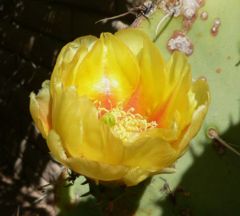Opuntia engelmannii
| Opuntia engelmannii subsp. var. | cow's tongue cactus, discus prickly pear, Engelmann's prickly pear", etc | |||||||||||||||||||||||||||||||||||||||||||||||||||||||
|---|---|---|---|---|---|---|---|---|---|---|---|---|---|---|---|---|---|---|---|---|---|---|---|---|---|---|---|---|---|---|---|---|---|---|---|---|---|---|---|---|---|---|---|---|---|---|---|---|---|---|---|---|---|---|---|---|

|
|
| ||||||||||||||||||||||||||||||||||||||||||||||||||||||
| ||||||||||||||||||||||||||||||||||||||||||||||||||||||||
Opuntia engelmannii is a prickly pear common across the southwestern United States and northern Mexico. It goes by a variety of common names, including "cow's tongue cactus", "cow tongue prickly pear", "desert prickly pear", "discus prickly pear", "Engelmann's prickly pear", and "Texas prickly pear" in the US, and "nopal", "abrojo", "joconostle", and "vela de coyote" in Mexico.
Its overall form is generally shrubby, with dense clumps up to 3.5 m high, usually with no apparent trunk. The pads are green (rarely blue-green), obovate to round, about 15-30 cm long and 12-20 cm wide. The glochids are yellow initially, then brown with age. Spines are extremely variable, with anywhere from 1-8 per areole, and often absent from lower areoles; they are yellow to white, slightly flattened, and 1-6 cm long. The flowers are yellow, occasionally reddish, 5-8 cm in diameter and about as long. The purple fleshy fruits are 3-7 cm long.
Its range extends from California to Louisiana in the US, and Baja California to Chihuahua in Mexico.
Flowering is in April and May, with each bloom lasting only one day, opening at about 8AM and closing 8 hours later. Pollinators include solitary bees, such as the Antophoridae, and sap beetles.
In the Sonoran Desert, terminal pads face predominantly east-west, so as to maximize the absorption of solar radiation during summer rains. Although found occasionally in the Mojave Desert, it tends to be replaced by Opuntia basilaris, which does not need the summer rain.
| Standard Cyclopedia of Horticulture |
|---|
|
Opuntia engelmannii, Salm-Dyck. An erect to semi-prostrate, profusely branching, coarse plant, 2-5 ft. high, forming large, impenetrable thickets, usually with a short, more or less terete, woody trunk, with grayish bark which becomes unarmed with age: joints broadly obovate to orbicular, pale to bluish green, very variable in size, in large specimens 12-14 in. long and nearly as wide, moderately thick: areoles remote, about 1 in. apart, with gray wool and large, rigid, gray to yellow, unequal bristles: spines mostly 2-4, sometimes 1-3 small additional ones, very variable, horny, variously colored, mostly yellow, or white with reddish base, usually compressed or angular and curved or twisted: fls. yellow, red within, fading to red, 2½-3 in. diam.: fr. broadly pyriform to globose, frequently 2 in. diam., dark purple, with insipid purple flesh. U. S. and Mex.— This species, with its numerous varieties, is the most widely distributed and abundant of the large flat- stemmed opuntias in the U. S. It varies greatly in different localities, and its many forms have not as yet been adequately defined.
|
Cultivation
Propagation
Pests and diseases
Varieties
Gallery
References
- Standard Cyclopedia of Horticulture, by L. H. Bailey, MacMillan Co., 1963
External links
- w:Opuntia engelmannii. Some of the material on this page may be from Wikipedia, under the Creative Commons license.
- Opuntia engelmannii QR Code (Size 50, 100, 200, 500)

